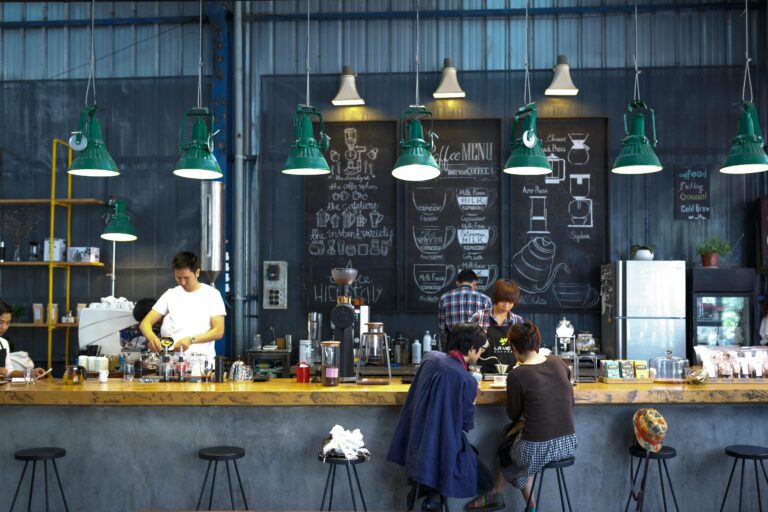As an F&B owner or operations manager, evaluating how your business is doing is essential to let your company scale.
1. Sales Per Square Foot
Tracking the sales per square foot of your store can tell you how efficient you are with the use of space. It can give insights for improving store layout, merchandising and even staff performance.
It is calculated by dividing the total in-store sales by your store’s selling area in square feet (excluding non-selling areas like store rooms).
You can maximize sales per square foot in your stores by:Optimizing your shop’s layout by decluttering and making full use of every space.
Increasing utilisation of your space across a day, such as converting your bar to a cafe in the day!
Working on ways to directly increase your sales revenue.
Test different types of offers and discounts. Look at what brings in sales (without cutting too much into your margins).
Provide opportunities for customers to engage with your brand! Set up a loyalty program that not only encourages customers to shop at your stores but also entices to spend more and come back. We all know of the Starbucks loyalty program, where customers are rewarded with food and drinks based on their accumulated points and current tier. Not only does this encourage more spending, it helps Starbucks build a loyal customer base. In addition, their newsletters also keeps their customers in the loop with deals and membership promotions.
Invest in educating your staff and recognise their efforts. Your staff directly impacts sales and customer satisfaction. Without great employees, your store performance will likely suffer.
2. Sales per Labour Hour (SPLH)
The SPLH of your store tells you how busy or productive your staff are. It represents the number of sales each person on shift is responsible for making. We all agree that one of the main goals for F&B businesses is to achieve high productivity levels at reduced cost. As such, your SPLH could help you to make that very important management decision!
Your SPLH is calculated by dividing your total sales revenue by the amount of hours worked by your staff.
For example, if your Target Sales for Friday is $5,000 and your scheduled hours are 50, then your target SPLH is $50. In other words, you plan to schedule 1 hour of work for every $50 in planned sales.
Your SPLH can help you plot out your store’s foot traffic, and thus predict peak hours. You can then better allocate the optimal number of employees to work based on the demand during your shifts, and possibly their wages too! This way, you can also schedule your additional tasks such as stock replenishment and petty cash tabulation to be completed during low volume sales periods. Through this, your SPLH can also help you identify the most productive sales activity and for you to design consistent, cyclic sales processes.
3. Overtime Hours
Did you know that people are only really productive for 3 hours a day? As the hours drag on, it becomes less likely that those final overtime hours include peak productivity. If unscheduled overtime hours has always been your solution to “behind schedule” circumstances, think twice. You might just be paying more for the same amount of work, in addition to stressing and burning out your overworked employees.
Here are the top 3 causes of increasing unscheduled overtime hours:
Ineffective scheduling. Manage your manpower wisely. Plan hours according to your business’s needs. Do not have a staff load that your business can’t handle.
Inaccurate timesheets. When there’s no proper record of employee timesheets, owners tend to overpay or underpay their staff. Human errors when tabulating timesheets are unavoidable, but they too, they can be costly.
Unenforced timekeeping. The most costly habit is probably unenforced timekeeping, where employees come early and leave late. In worse cases, your F&B might not even have a proper clock-in and clock-out (CICO) system to keep track of it!
To reduce overtime hours compared to the previous week, here is what you can do to reduce it:
- Have a proper CICO system so that you can finally keep track of your staff’s punctuality too.
- Invest in a timesheet system that pairs up with your CICO system.
- If long hours decrease productivity, one solution would be to hire part-timers. Part-timers don’t require overtime wages, and their productivity levels aren’t affected by a full day of work at your company.
4. Part-Timer to Full-timer (PT to FT) Ratio
Your PT to FT ratio gives you a better gauge on how to efficiently and optimally schedule your staff for maximum productivity in your stores.
Before deciding the ratio, here are some pros and cons when it comes to scheduling in part-timers and full-timers:
Why part-timers?
- They make it easier for smaller F&Bs to scale by cutting cost while giving you more flexibility to experiment.
- They can fill up your shifts not covered by your full-timers.
- You have no obligation to schedule your part-timers if the workload does not require it.
- They receive less benefits than full-timers, and might be even paid lesser for the same work as full-timers.
Why not part-timers?
- They are less committed. less skilled as such. This might affect their motivation to contribute good work to your F&B.
Why full-timers?
- Full-timers have higher commitment levels and are hence more skilled at their respective jobs.
- You could potentially invest in them for training and skills upgrading, and thus they will increasingly provide even more value for your F&B.
Why not full-timers?
- They cost a lot more.
- It is not easy to find good staff, yet alone retain them!
- You would have less flexibility in scheduling.
At the end of the day, it is not just about maximising your part-timer count to cut the most costs, or to maximise your full-timer count for maximum producitivy. The solution is to know what’s best and necessary for your F&B and make adjustments to your PT to FT ratio.
5. Planned vs Actual hours Worked
Your number of planned hours often does not tally with the number of actual hours worked.
Here is why you need to compare them:
- To minimise late arrivals, early departures and extended breaks. These are all costly habits.
- To improve service and productivity, as the relationship between actual and scheduled hours highlights what is necessary for the company to achieve to improve or meet your F&B’s profitability goals.
To utilise this metric, determine if “actual” hours are costing you more than “scheduled” hours. Establish labor cost controls such as tracking employee timesheets for repeat “overtime offenders”, enforcing stricter CICOs, and cut shifts if your F&B does not support your staffing load. This can help you lower your labor and overtime costs.
We hope that these metrics can help your F&B business in terms of cutting costs and achieving optimal performance at the same time. However, all of these would be hard to attain without a proper staff management system. Here at StaffAny, our goal is to empower owners and managers with automation to allow them to make time for what matters. With our application, mundane and tedious tasks – such as staff scheduling, timesheets, payrolls, and getting your staff to clock-in and out – will no longer be such a hassle anymore. Find out how at www.staffany.com.











